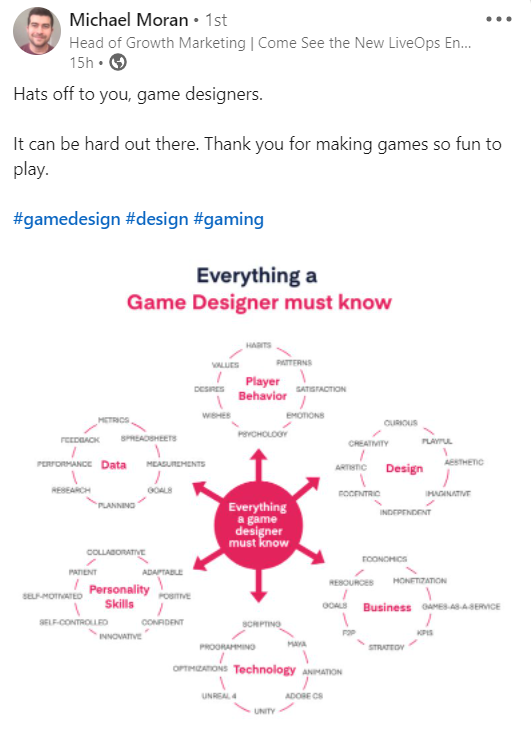A LinkedIn contact shared a mind map that summarises, from his point of view, everything a game designer needs to know.
His post was shared and appreciated by many professionals in the sector.
In my opinion, instead, the image is misleading. It just looks at one part of game development: free-to-play business. Free-to-play is only part of a very complex world ranging from board games to virtual reality. I know many people in Europe who are dedicated to the development of indie games and I can assure you that, for example, the “Data” part is ignored by them.
This mind map contains what free-to-play game companies expect from a game designer. Which is very different from the declared purpose.
A person with in-depth knowledge in all of these areas is very likely to feel the work of a game designer frustrating. If I know the game-as-a-service business like the back of my hand, I will continually make proposals that probably won’t be heard. Frustration leads many game designers to jump to other roles, such as product management. Pure game designers, instead, are dedicated to something else!
When you work in free-to-play you gain knowledge in all these areas, but a game designer who does his job well devotes himself to two main activities:
- Facilitate tools in the team to decide how the game works
- Involve the people who will be playing the games in the process
Facilitate game design tools
The game designers are those who help define:
- the game systems
- the way in which the story reaches the players
- the experience in the game levels
- the actions necessary to activate the mechanics.
System design, narrative design, level design and gameplay design. In the case of free-to-play: economy design, content design, level design and UX design.
It is good to know the business side and the data side to be informed about what to do, but it is very important to be able to realise the very experience you want to offer people in the game. The necessary qualities are of a technical, artistic and editorial nature.
- Create and use spreadsheets, touch JSON files and game engines (technical).
- Set up a process, help define the essence of your experience and study well the armony of all the elements of your game (artistic).
- Document everything and write stories both for internal inspiration and for the Players (editorial).
Involve people
Too often, busy with many daily tasks, team members forget the main component of a commercial video game: the Players.
Most video games in production will not be commercially successful for exactly this reason. The task of game designers is to involve real people constantly to test the assumptions you have about the players and the market. A desk is a dangerous place from which to view the world. You need to go outside, watch people play the game and have meaningful conversations with them.
Product managers, programmers and artists don’t have the time to do this. It is up to the game designers to take care of this. If you don’t, the work comes down to constant deliveries over long periods of time and then comes to nothing. It happens very often.
Conclusion
Game design is a very complex activity, but the role of game designers is very practical and creative. It is about analysing the games and helping the team to define the tools to create the game. Then you will create gaming experiences using these tools.
It is good to know a little bit of everything. Of course, if you want to have a meaningful discussion with a product manager you should speak the language of the business. If, on the other hand, you want to have a conversation with the art director, learning about the history of art and the theory of colours can help you a lot.
But let’s never forget the fundamentals. We game designers do a very practical job!
